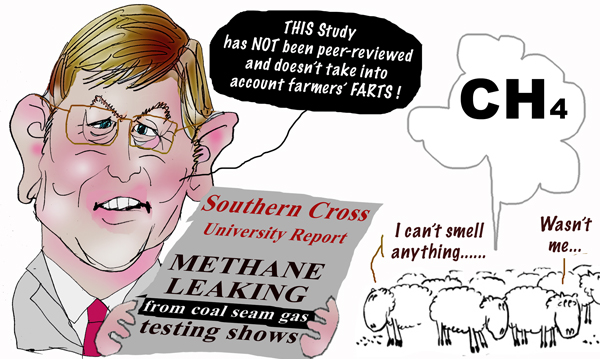Search
Recent comments
- chez bibi's....
9 hours 26 min ago - might is right.....
10 hours 33 min ago - revenge......
12 hours 11 min ago - on life support....
12 hours 20 min ago - moving on....
13 hours 7 min ago - in finland....
13 hours 12 min ago - a mosaic....
13 hours 15 min ago - the mad house....
14 hours 59 min ago - RT metro....
17 hours 45 min ago - EU piglets...
1 day 6 hours ago
Democracy Links
Member's Off-site Blogs
farting around...

Energy and Resources Minister Martin Ferguson has accused researchers who identified a massive coal-seam gas leak in Queensland of a cynical attempt to grab headlines.
Speaking at an energy conference in Sydney, Mr Ferguson said he believed the study by Southern Cross University researchers Isaac Santos and Damien Maher, which found that masses of methane and carbon dioxide were leaking undetected from Australia's biggest coal-seam gas field, abandoned usual scientific practice.
He criticised the study's public release, before it had been peer-reviewed, saying that in "the scientific community that is not regarded favourably".
Read more: http://www.smh.com.au/environment/minister-slams-unscientific-report-on-gas-leak-20121120-29nj5.html#ixzz2ComS9BHM
- By Gus Leonisky at 21 Nov 2012 - 11:54am
- Gus Leonisky's blog
- Login or register to post comments
methane
Methane (pronounced /ˈmɛθeɪn/ or /ˈmiːθeɪn/) is a chemical compound with the chemical formula CH4. It is the simplest alkane, the main component of natural gas, and probably the most abundant organic compound on earth. The relative abundance of methane makes it an attractive fuel. However, because it is a gas at normal conditions, methane is difficult to transport from its source.
Methane is a relatively potent greenhouse gas. The concentration of methane in the Earth's atmosphere in 1998, expressed as a mole fraction, was 1745 nmol/mol (parts per billion, ppb), up from 700 nmol/mol in 1750. By 2008, however, global methane levels, which had stayed mostly flat since 1998, had risen to 1800 nmol/mol
http://en.wikipedia.org/wiki/Methane
Note : methane is odorless. Belching of cows produces methane. farmer's farts are mostly — like those of everyone else — hydrogen.
leaks or belching?...
Dr Santos said in a university release:
The current discussions on CSG are often based on anecdotal evidence, old observations not designed to assess CSG or data obtained overseas. We believe universities are independent institutions that should provide hard data to inform this discussion. The lack of site-specific baseline data is staggering.
In an interview with the Australian Broadcasting Corporation, Dr Maher said while it was not possible yet to say “definitively” that the raised levels of methane were due to leaks from the CSG facilities, “we have multiple lines of evidence to suggest that that is what is causing it”. He said the initial findings pointed to the CSG operations as a likely source of the raised methane levels – in particular, from “fugitive emissions.
“Essentially these are leaks. It is where CSG that was in the coal seam leaks into the atmosphere. That can leak through the infrastructure – the well head, through pipes – and the industry knows about these leaks and they are relatively easy to deal with. What we are looking at is the potential for that methane to migrate through the soil structure.”
The Australian Petroleum Production and Exploration Association, which represents the CSG industry, said in a press release the research was premature and appeared to deliberately target the CSG industry. Spokesman Rick Wilkinson personally attacked the scientists, saying their findings “diminishes the good work by many other scientists”.
But the response from the association’s spokesman Rick Wilkinson contained several misrepresentations. Wilkinson claimed the research was “notable through omission rather than content” because, he said, it seemed “squarely aimed at natural gas production rather than all sources of actual and potential greenhouse gas emissions”.
read more: http://www.independentaustralia.net/2012/environment/gas-industry-attacks-scientists-bearing-bad-csg-news/
A thousand to one, the methane is from leaks in CSG exploitation...
leaks in the valley...
For more than two months, California has experienced a slow-moving environmental disaster: Methane leaking from a faulty natural gas well near the Los Angeles neighborhood Porter Ranch has displaced thousands of families and is releasing the greenhouse gas equivalent of driving 7 million cars each day. Here's what's going on:
When did all this start? On October 23, methane began leaking from a faulty well in Aliso Canyon, the site of a natural gas storage facility owned by Southern California Gas company. Since then, the well has been releasing about 70,000 pounds of methane every hour—equivalent to about a quarter of the state's methane emissions, according to CBS News. (Methane is a particularly powerful greenhouse gas; pound for pound, it traps 86 times more solar radiation than CO2over a 20-year period.) SoCalGas estimates the leak won't be fixed until February or March.
read more: http://www.motherjones.com/environment/2016/01/california-methane-leak
See article and toon at top...